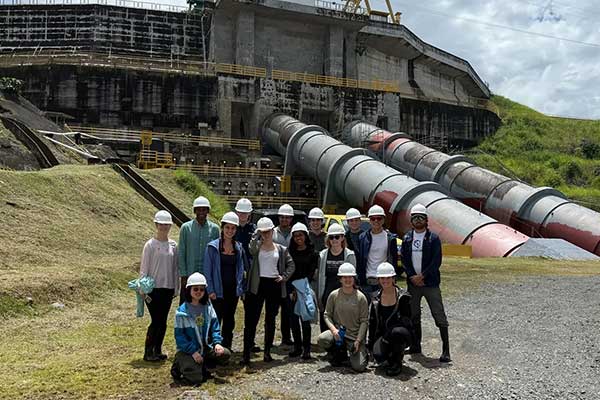Professor and Students Journey to Panama Canal to Study Fluid Mechanics

MIE Associate Professor Carlos Hidrovo and eleven mechanical engineering students ventured on a month-long Dialogue of Civilizations trip to the Panama Canal to study fluid mechanics.
This article originally appeared on Northeastern Global News. It was published by Cesareo Contreras. Main photo: Earlier this summer, a group of mechanical engineering students traveled to Panama for a Dialogue of Civilizations trip centered on fluid mechanics. Courtesy Photo.
Northeastern engineering students examine the role of fluid mechanics firsthand at the Panama Canal
The Panama Canal is one of the most important waterways in the world, allowing fast passage for ships between the Pacific and Atlantic oceans.
With its 12 lock chambers that use water and gravity to raise and lower ships, the 50-mile route is also a major feat of engineering.
It relies heavily on fluid mechanical concepts such as hydrostatics and gravity flow, explains Carlos Hidrovo, associate professor of mechanical and industrial engineering at Northeastern University. Those are the principles that Hidrovo teaches his undergraduate students at Northeastern in his fluid mechanics class.
While students have always been able to take the class on the Boston campus, since 2021 Hidrovo has led a Dialogue of Civilizations trip to Panama in which students can opt to take the class in the Central American country to see how the concepts they are learning in class are being implemented in the real world.
This summer, 11 students joined Hidrovo on a month-long trip to the country, making stops at the canal just outside Panama City, a wind farm in Penonomé and hydroelectric power facilities in the Chiriqui Highlands.
In addition to taking the fluid mechanics class, students were also enrolled in a separate cultural project course. For that course, students were put into separate groups and tasked with writing a report and presentation focused on one of the three engineering projects they visited.
Pranshu Sangal, a third-year mechanical engineering student, was tasked with investigating the Panama Canal’s cultural and socioeconomic impact for his group project.
The canal was built by the United States and was under its control until 1977, when President Jimmy Carter began the handover to Panama, Sangal says. Today, it is a major part of Panama’s economy, generating billions of dollars in revenue a year.
The canal’s last major expansion was in 2016, Sangal explains, highlighting a system of new NeoPanamax locks that were installed to allow for the passage of larger vessels.
Sixty percent of the water used to power those locks is recycled. The other 40% comes from Gatun Lake, the manmade lake that sits atop the canal that the ships cross through, he explained.
Sangal spoke firsthand with residents living within proximity of the canal, as well as local Panamanian economists. And of course, he saw the canal in action.
“Actually being there and seeing huge vessels rise up and go down, it was like, ‘Wow, it’s all fluid mechanics,’” he says.
It was also an eventful month for Diana Sooknauth, a fourth-year mechanical engineering student at Northeastern, who described the experience as rigorous but enriching.
“The whole itinerary is very intentional. While we were learning the first concepts that applied to the Panama Canal, after we learned those concepts, then went to the Panama Canal,” she says, highlighting now she has a better understanding of the conservation of mass and the conservation of momentum after seeing how they apply to the Panamanian landmark.
For her project, Sooknauth was tasked with investigating the Penonomé Wind farm, the largest wind farm in Central America. The 270-megawatt project provides 7% of the country’s energy needs.
Read full story at Northeastern Global News